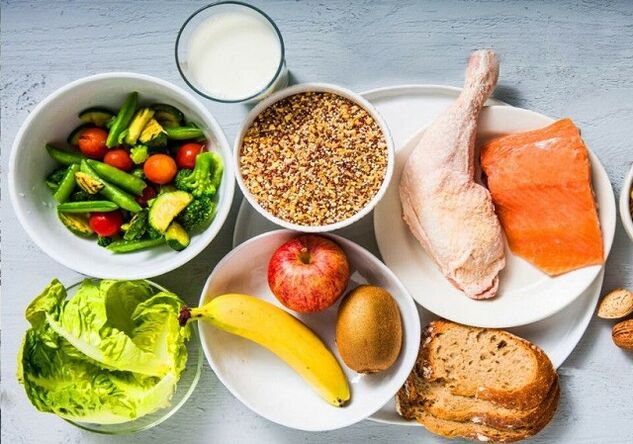
A therapeutic diet for gastritis reduces anxiety and relieves stomach pain caused by inflammation. Properly selected menu increases the effectiveness of therapeutic measures and normalizes digestion. Special dishes for gastritis include treatment tables 1, 2, 3, 4, 5. The choice of a particular menu depends on the acidity of gastric juice and the duration of the disease.
Tables 1, 4, 5 are presented in several variants. In the number of basic diets, it is determined by letters and is used based on the severity of symptoms, the period of the disease (acute, pale, chronic form).
For gastritis, it means to organize a proper diet, to completely reconsider your diet, to eliminate foods that irritate the gastric mucosa. In the presence of this disease, emphasis is placed on steamed and boiled dishes. It is forbidden to eat spicy, fried, fatty foods for all types of gastritis.
Therapeutic diets for people with certain diseases were developed in 1929 by scientists. The diet system consists of 15 main tables showing options and fasting periods.
It is organized taking into account the rules of eating for gastritis:
- optimal temperature of containers;
- food intake should be carried out simultaneously, meals should be fractional, 5-6 times a day;
- overeating is not allowed;
- When choosing a diet, take into account the accompanying diseases;
- alcohol, smoking are excluded;
- you should avoid smoked, sour, spicy foods;
- it is recommended to have lunch 2-3 hours before bedtime;
- the food should be chewed well;
- it is better to refrain from snacks while running;
- drink fluids 30 minutes after a meal;
- boil the dish well.
This regimen has a positive effect on the gastric mucosa and heals it. The menu for gastritis should be varied, contain sufficient amounts of nutrients, vitamins and minerals. The patient does not need to go hungry.
List of drugs for gastritis
A therapeutic diet for patients with gastritis involves the use of foods that restore damaged mucosal cells. Foods rich in B vitamins are accepted. By the way, there is a deficiency of this vitamin in diseases of the gastrointestinal tract. Useful foods for all forms of chronic gastritis:
- oatmeal - a source of fiber, antioxidants;
- vegetable oils - fatty acids, tocopherols;
- dairy products (if well tolerated, will not cause swelling);
- fermented dairy products and beverages - normalizes intestinal function due to the abundance of beneficial microorganisms that help maintain a healthy immune system;
- ripe banana - stimulates the production of protective mucus, rich in B vitamins, magnesium;
- berries - better absorbed than fruits, non-acidic species are selected with increased secretory fluid production;
- white rice - has absorption properties;
- Potatoes - normalizes metabolism, raw vegetable juice is used for medicinal purposes.
Proper drinking regimen will help alleviate the situation in case of inflammation and anxiety. Fluid improves intestinal motility and digestive system, dilutes excess acid in the stomach. The volume of still water should be at least 1. 5 liters per day.
Features of high acidity nutrition
The gastroenterologist prescribes a diet after pH -metry - a diagnostic procedure that measures the acidity of the stomach. It is usually done during endoscopy.
Symptoms of acidic gastritis may include heartburn, rib pain, and eating. The menu of Table 1 is recommended when inflammation appears due to excessive fluid production.
The patient is prescribed a strict diet to normalize the acidity (pH level). Any entertainment on the menu can cause discomfort and pain.
The list of permitted products that restore the mucous membrane and reduce gastric acidity is as follows:
- liquid porridge;
- lean soups;
- side dishes - mashed potatoes, boiled vegetables, wheat pasta, well-cooked buckwheat, rice;
- lean meat and fish meatballs, meatballs;
- Pendir;
- veal-based sausage;
- dairy products;
- sweet fruits, berries;
- stale bread, crackers;
- cheese casserole;
- jelly, souffle;
- For dessert - honey, marshmallows, marmalade, pitted raisins, dry biscuits.
The menu should include butter and vegetable oil. During remission, the main dishes of meat and fish can be cooked whole. Vegetables are used only in boiled form.
Fresh onions and garlic irritate the inflamed mucous membranes, so they should not be eaten for gastritis. Small amounts of these boiled vegetables are allowed.
Weak tea, rosehip decoction, milk gel and dried fruit compote are the most useful drinks for people diagnosed with hyperacute gastritis.
What not to eat with gastritis
List of foods forbidden for gastritis:
- Salo;
- meatballs;
- liver;
- mushrooms;
- margarine, spread;
- fast food;
- Rye bread;
- heavy cream;
- coffee;
- chocolate;
- spices;
- fresh fruits (except bananas, sweet apples, pears);
- radish;
- Ice cream;
- confectionery;
- baking;
- Canned food;
- carbonated drinks;
- salted cheeses;
- lollipops;
- marinades.
As the disease progresses, you should limit the use of pasta, seafood, seeds, nuts. In addition to inflammation of the stomach, if there is still liver and gallbladder disease, eggs are used as components of food. Eating them separately in the form of omelets is undesirable for the combination of gastrointestinal diseases.
Foods allowed for hyperacid gastritis
Treatment with a therapeutic diet that excludes foods that increase the production of fluid secreted in the stomach, will help to normalize the level of acidity.
Diet therapy significantly accelerates the healing process with superficial focal gastritis. In most cases, minor damage to the mucous membrane heals within 10-14 days with the help of a medical menu and medication. With deep lesions, proper nutrition is recommended for life.
List of foods that can be eaten for gastritis with high acidity:
- Flour products. It is allowed to eat yesterday's wheat flour bread, long-lasting biscuits.
- Cereals. The most useful for the stomach are rice, buckwheat, oats.
- Vegetable puree. It is recommended to make a salad from vegetables.
- Eggs. You need to boil them well. Eggs should not be more than 3 times a week.
- Dairy products. They already neutralize stomach acid.
- Cheese is hard and cottage cheese.
- Lean meat. The most useful species for gastritis are turkey, rabbit.
- Low-fat sea and river fish. Suitable for pollock, cod, pink salmon, fish, hake, pike.
- Sweets. Allowed sweets include honey, jelly, marshmallows, marmalade, marshmallows. You can cook casserole without cooking.
- Still mineral water.
Features of the diet for hypoacid gastritis
In people with low acidity, digestion is slowed down due to enzyme deficiency. Symptoms of this disease are poor appetite, weight loss, pale skin, vitamin deficiency.
Coarse food causes inflammation. The following are prohibited for people with hypoacid forms of gastritis:
- peeled fruit;
- berries with seeds - raspberries, strawberries, currants;
- pure milk.
The list of foods for gastritis with high acidity is the same as the form of hyperic acid. There are also differences in diet. Allowed to use at low acidity:
- sour fruits, vegetables and berries (citrus fruits also belong to this group);
- salty cucumber;
- tomato;
- fruit juices.
Special attention is paid to chopping food. It is recommended to take the food in a calm atmosphere and chew it thoroughly. There may be intolerance to meat, milk, eggs with low acidity. In this case, foods that cause discomfort to avoid complications of gastritis are excluded from the diet.
They follow a diet based on increasing the production of gastric juice to increase the level of acidity. In addition to the permitted products, the doctor often prescribes digestive enzymes.
Nutrition with exacerbation of the disease
The menu is based on Table 1a. Restrictions are observed for 5-7 days. When the symptoms disappear, the diet is gradually expanded. If acute gastritis is accompanied by vomiting and diarrhea, the body needs more fluid. Water helps restore water-salt balance. If the active phase of the disease is accompanied by pain and constipation, Table 1b is recommended.
Approximate menu of the 1B diet table:
- 1st breakfast: steamed omelet from 2 eggs, semolina porridge, milk.
- 2nd breakfast: milk.
- Dinner: mashed rice, milk soup, steamed meat souffle with mashed potatoes, apple jelly.
- Afternoon snack: rose broth, crackers.
- Lunch: steamed cottage cheese souffle, fruit jelly.
- Night: milk.
The diet for acute gastritis consists of liquid and ground foods that promote the improvement of the gastric mucosa:
- delicate soups with rice and rolled oats;
- steamed cutlets, souffle with minced meat;
- viscous porridge;
- jelly;
- weak tea
Features of Table 5
When gastritis, cholecystitis, combined with liver disease, the patient is recommended diet table number 5. It is also prescribed for people with mild gastritis. Diet restricts the consumption of foods rich in uric acid. The list of prohibited foods includes liver, yeast, canned fish, salmon, mushrooms, shrimp and mussels. The use of egg yolk should be limited.
Sample menu for chronic gastritis
Gastritis dishes include a variety of foods that have been heat-treated for a long time. The easiest way to follow a special diet is to prepare a menu in advance for the coming week.
The daily ratio of sugar is 20 g, bread - 250 g, butter - 20 g. The menu is designed for 6 meals. 3 of them are breakfast, lunch, dinner and 2 snacks. Baked apples, pears, bananas, biscuits are allowed for afternoon snacks. Suitable for drinks, rose infusion, compote. Drink a glass of milk or kefir 2 hours before bedtime.
Diet recipes
Most of the diet consists of liquids and chopped foods. The recipes of the listed dishes are suitable not only for adults, but also for children. A therapeutic diet for gastritis allows the use of unleavened bread. The ideal choice is biscuit biscuits.
With gastritis, it is necessary to eat regularly, in small portions and to avoid overeating.
Porridge is best for breakfast with gastritis. The grains are boiled well and boiled for 10-15 minutes under the lid. Barley, barley and pea porridge are prohibited for gastritis. The food should be viscous or liquid to give a delicate effect.
Pour the rice into 400 ml of boiling water and cook on low heat until the liquid is absorbed. Add 2 tablespoons of sugar, ½ teaspoon of salt to the porridge and slowly pour 400 ml of milk. Boil the rice for 15-20 minutes. Cover and leave for 5-10 minutes. You can add a piece of butter to the porridge before serving.
Soup recipes
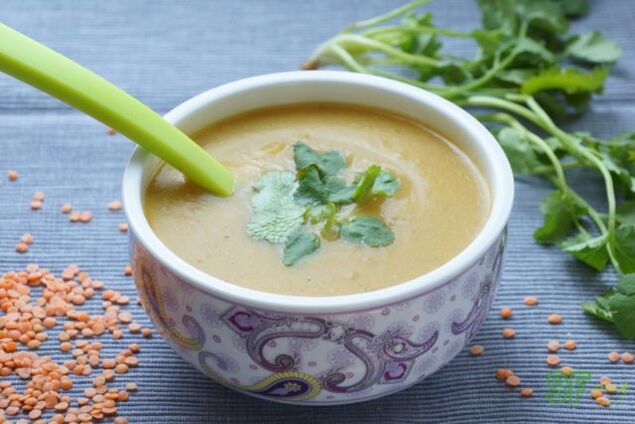
The first courses include vegetarian soups. Rich broths increase the production of secretory fluid, so it is contraindicated for people with gastric acidity and ulcerative gastritis. The best choices for the first course are slimy rice soup and vegetable puree soup.
To make oatmeal soup, you will need 0. 5 oats, 600 ml of water and salt. Oatmeal is cooked for 10-15 minutes. Such a soup can be prepared by adding lleison - a mixture of milk and eggs. Added at the end of cooking. Beat eggs and 200 ml of milk in a separate bowl. The finished soup is filtered through a sieve. It is then whipped and boiled again. Lezon is poured in a thin stream 5 minutes after the oven is turned off. In this case, the contents are constantly mixed to obtain a homogeneous mass.
Boneless rice soup can be made with milk.
Ingredients:
- 55 g of cereals;
- 400 ml of milk;
- 150 ml of water;
- vegetable oil;
- salt;
- 2 teaspoons sugar.
The rice is washed and boiled in water until half cooked. Then add milk, sugar, salt. Season with vegetable oil, crackers before serving.
Dietary foods for gastritis include vegetable broths. For example, cauliflower soup. To prepare the broth you need a little onion, carrot, 200 grams of cabbage. Boil the vegetables for 15-20 minutes and then chop with a mixer. Bring the puree soup to a boil, add 10% cream and turn off the heat. Sprinkle herbs on the finished dish.
Meaty souffle
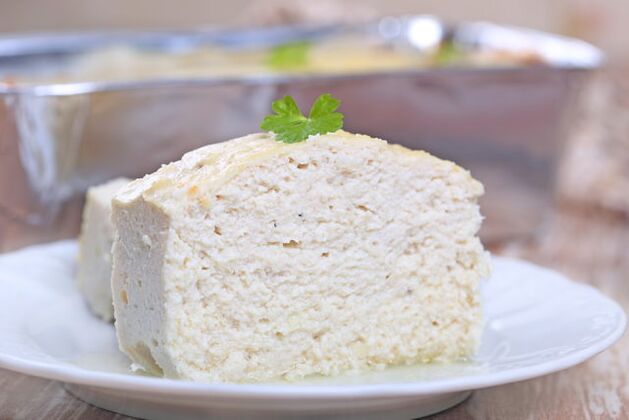
Second courses are made from whole meat or minced meat. An alternative to steamed cutlets is meat souffle. Get 300 grams of beef to eat. Can be replaced with a rabbit, chicken. For gastritis it is better to give up pork and lamb. Fatty species cause inflammation of chronic gastritis.
Boil and chop the meat until soft. In a separate bowl, beat 2 yolks and a tablespoon of sour cream. Add hot salt water to taste and mix until a homogeneous mass is obtained. It is not recommended to use boiled meat, because the diet for gastritis excludes rich broths.
Spread the mixture into a mold greased with butter. The remaining egg whites are beaten with a mixer until a stiff foam is formed and added to the total mass. The souffle is baked in the oven at 180 ° until a light crust appears.
Meatballs
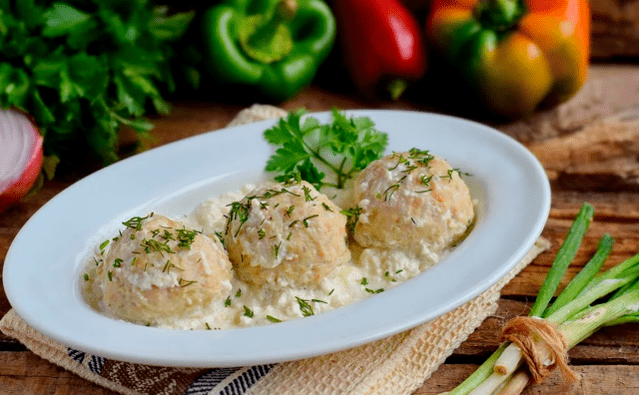
The fish, cleaned of bones, passes through a meat grinder. The minced meat is combined with an egg, 1 tablespoon flour, salt. The resulting mixture forms small balls. Fill the non-stick ceiling ¼ part with water. The resulting meatballs are immersed in boiling water and boiled on low heat for 25-30 minutes.
Vegetable casserole
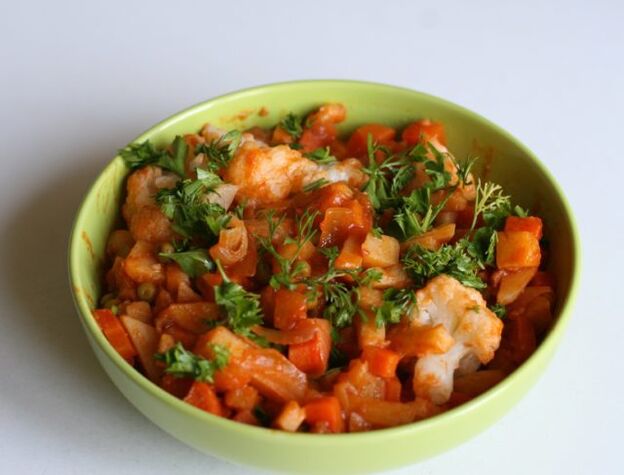
Ingredients:
- cauliflower;
- potato;
- onion;
- pumpkin;
- carrots;
- salt;
- olive oil.
Pour a little water on the onion and cook the carrots in a frying pan. After 10 minutes, add the rest of the chopped vegetables. Cook the casserole until soft. Cooking time 20-30 minutes. Olive oil is added to the vegetable stew before serving.
desserts
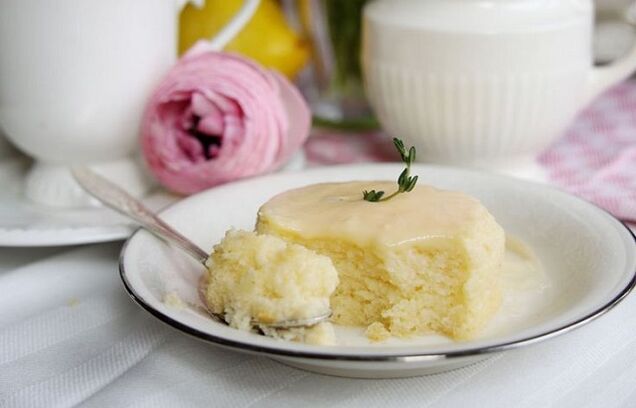
To make rice pudding, you will need:
- 100 g of rice and cottage cheese;
- 1 cup milk;
- 1 glass of water;
- eggs;
- 3 teaspoons sugar;
- 4 tablespoons 15% sour cream;
- a pinch of salt.
Boil wheat in milk and salt water, rub until smooth. Then add the remaining ingredients except sour cream and mix thoroughly. The pudding is cooked in a greased bowl in a water bath. Ready meals are eaten with sour cream.
Fruit jelly can be prepared with jam, water and gelatin according to the proportions indicated on the package. You will need 2 cups of jam, 200 ml of water and 5 teaspoons of powder to make the dessert. The gelatinous water is placed in a water bath and heated to a liquid state, jam is added. The ingredients are mixed well and distributed in molds. Put in the refrigerator for 2 hours to thicken the gel.
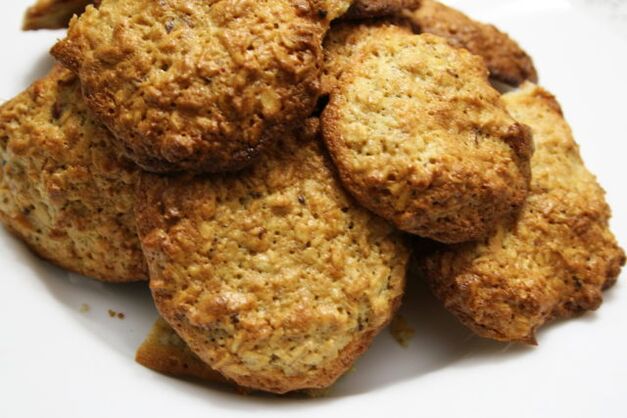
Bread
Butter dough should be excluded from the therapeutic diet for gastritis. Official baked goods are allowed no more than 1-2 times a week. Casserole, biscuits and oatmeal cookies will become a substitute for bread for stomach ailments. Low-fat pancakes, oven-baked and cheesecakes are also allowed.
Hercules biscuits:
- 200 grams of crushed flakes;
- 200 g of baby fruit puree;
- 40 g of dried apricots or raisins;
- Coconut flakes.
All ingredients are mixed and turned into flat balls. Bake in a loaf pan at 180 ° for 30 minutes. It is recommended to cover the form with parchment paper.
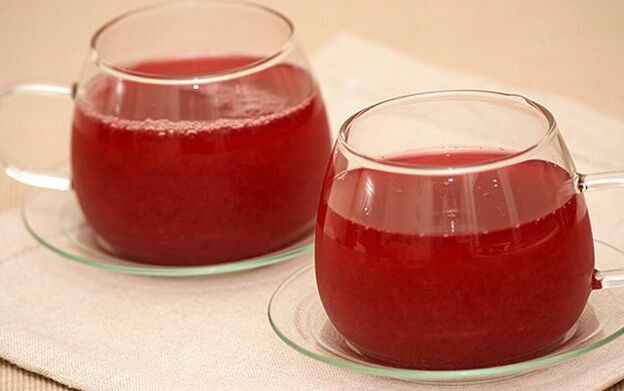
How to cook jelly
Ideal for making fresh berries and jam jelly. For 1 liter of drink you need 1 tablespoon of starch and 100 grams of jam. Bring the jam water to a boil and strain it. The starch is dissolved in 100 ml of cold liquid and poured into the resulting syrup. Kissel should be boiled over medium heat. In addition, you need to constantly stir. The fire is extinguished after the appearance of foam on the surface of the gel.
Drinks
For compote you need a mixture of dried apricots, raisins, apples. Dried fruits are poured into the pan after boiling water. Cooking time is 15-20 minutes. You can make compote from non-acidic berries without apples.
By using healthy diet recipes, you can not only treat stomach ailments, but also lose a few pounds without harming your health.
The timing of a therapeutic diet for gastritis will depend on the severity of symptoms and the degree of inflammation. As a rule, it is recommended by the attending physician. The menu of diet tables is used for the treatment and prevention of exacerbations of diseases of the gastrointestinal tract. Proper nutrition will help relieve unpleasant symptoms, pain and discomfort in the stomach.
















